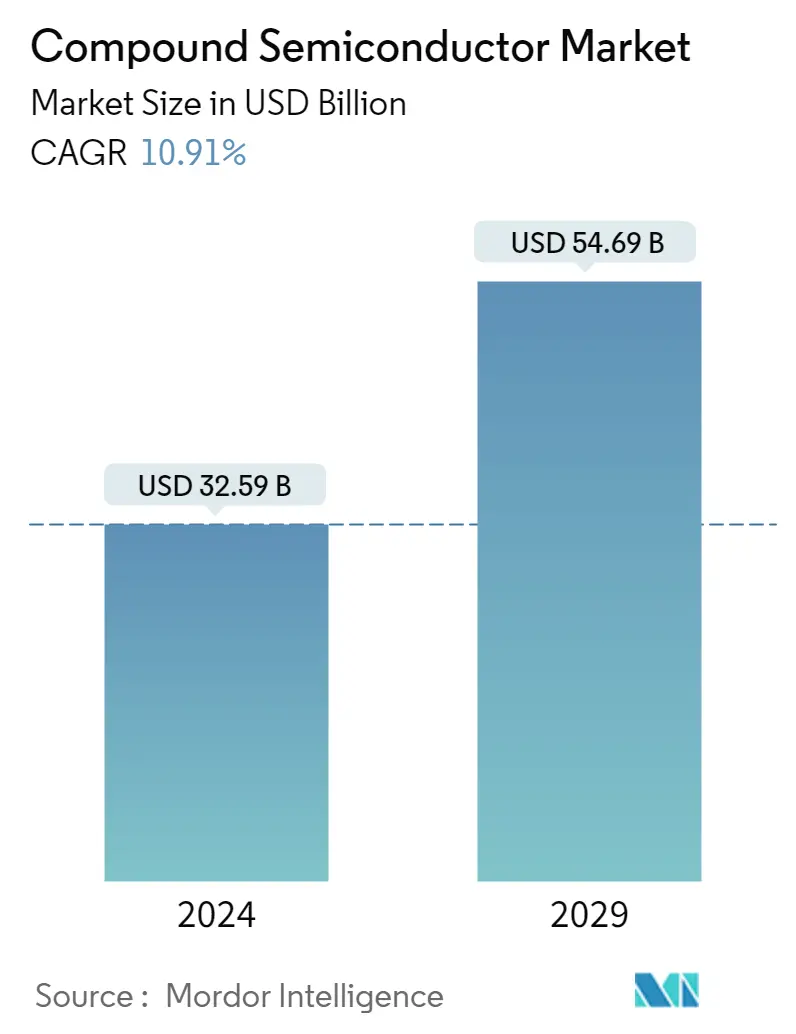Market Size of Compound Semiconductor Industry

| Study Period | 2019 - 2029 |
| Market Size (2024) | USD 32.59 Billion |
| Market Size (2029) | USD 54.69 Billion |
| CAGR (2024 - 2029) | 10.91 % |
| Fastest Growing Market | Middle East and Africa |
| Largest Market | Asia-Pacific |
Major Players*Disclaimer: Major Players sorted in no particular order |
Need a report that reflects how COVID-19 has impacted this market and its growth?
Compound Semiconductor Market Analysis
The Compound Semiconductor Market size is estimated at USD 32.59 billion in 2024, and is expected to reach USD 54.69 billion by 2029, growing at a CAGR of 10.91% during the forecast period (2024-2029).
The COVID-19 pandemic halted the manufacturing of several products in the compound semiconductor production industry owing to continued lockdown in critical global regions. In addition, country-wise lockdowns inflicted by governments across the globe further resulted in sectors taking a hit and disrupting supply chains and manufacturing operations worldwide. Most manufacturing operations, including the factory floor work, were significantly affected, resulting in decreased productivity.
- Compound semiconductors are made from two or more elements of the different or same group of the periodic table. These are manufactured by using various types of deposition techniques, such as chemical vapor deposition, atomic layer deposition, and others. They possess unique properties like high temperature and heat resistance, enhanced frequency, high sensitivity to magnetism, and faster operation and optoelectronic features are some of the key advantages boosting their demand. Moreover, the decrease in the manufacturing cost of compound semiconductors has increased their application in electronic and mobile devices.
- The ability of compound semiconductors to emit and sense light in the form of general lighting (LEDs) and lasers and receivers for fiber optics is further driving the demand. The decrease in manufacturing and installation cost of LEDs has increased its application in lamps and fixtures across all sectors. Mega-cities concentrate on investing in infrastructure development to meet the needs of the growing population, and governments are helping customers to install energy-efficient lighting sources to reduce their electricity consumption costs.
- For instance, during the pandemic, EESL (Energy Efficiency Services Limited) celebrated the completion of its one-year governmental project called the Unnat Jyoti Program (UJALA). Under this program, it substituted more than 10.6 million street light bulbs with LED lights to reduce the carbon dioxide footprint by 20 million tons and the electricity cost. Such initiatives further boost the market studied.
- In 2020, the Taiwan Semiconductor Manufacturing Company (TSMC) sourced about 31% of spare parts locally in China, which increased to 31% in 2021.
- According to the US Department of Energy (DOE), LED lights use about 75-80% less energy than traditional incandescent light bulbs and about 65% less energy than halogen bulbs. Commercial enterprises need lighting for an extended period, whether for long working hours, safety and security in a warehouse or manufacturing facility, or other uses. Thus, switching to LED lights can save millions of dollars annually. For example, US Energy Recovery clients can save about 20-55% on their electric utility bills by swapping out old lighting systems for state-of-the-art LED lighting. Therefore, the shift toward LED adoption is driving the growth of the market studied.
- The smartphone is the major consumer of compound semiconductors. The smartphone market has been very competitive in recent years. The increasing usage of mobile phones is further anticipated to drive the global market. For instance, according to the Ericsson Mobility Report, 2022, by the end of 2027, there will be 4.4 billion 5G subscriptions globally, accounting for 48% of all mobile subscriptions.
- The Internet of Things applications are increasing, which is expected to boost the sales of compound semiconductors. Moreover, the wireless communications sector is expected to grow with the growth in 5G networks. Fifth-generation networks also indicate the likelihood of consumers upgrading their mobile handsets or devices to drive global compound semiconductor adoption.
- The compound semiconductor industry is considered one of the most complex industries, not only due to the more than 500 processing steps involved in the manufacturing and various products but also due to the harsh environment it faces, e.g., the volatile electronic market and the unpredictable demand.
